Genre: Sports Developer: Accolade Publisher: Accolade Players: 1-4 Released: 1995
Rap/hip hop and basketball have this weird love affair going, which particularly manifested itself during the mid-’90s. For instance, star basketballer Shaquille O’Neil tried a career in rap during that period, with three albums released between 1993 and 1995 alone. Similarly, video games had a new tendency to try and keep the court game “real.” In 1995, the Super Nintendo received a basketball game taking place on the streets and back alleys, starring the names of many then-relevant rappers: the notoriously bad Rap Jam: Vol 1. And the very same year, the NKOTB (new konsole on the block), the Atari Jaguar, broke… ahem, brought us the video game adaptation of White Men Can’t Jump, a movie licensed tie-in about street b-ballers that is widely considered as one of the worst games of all time. So for what it’s worth, I can already say that the Genesis received the better 16-bit street basketball game of that year. That’s not saying much, though.
When Acclaim landed a smash hit with its arcade and home console version of NBA Jam, publisher Accolade responded by licensing the likeness of star basketballer “Sir” Charles Barkley (then) of the Phoenix Suns and released Barkley Shut up and Jam! in 1994, a game which I referred to as “NBA Jam on a budget” in an earlier review. Was it successful? Well, reviewers of the time were varied in their opinion, with an overall tendency of mediocre to good ratings. Then Acclaim pushed out a new, revised edition of its blockbuster called NBA Jam T.E. (Tournament Edition). So what did Accolade do? It released a sequel to its first game as well, as long as the license for Barkley was still valid, and creatively call it Barkley Shut up and Jam! 2” Unlike the first game though, which was published for both the Genesis and the SNES, this follow-up was a Genesis exclusive; a SNES version was apparently planned but never fully realized. The actual Genesis release was also rather obscure, to say the least. It wasn’t covered as much in the gaming press, and while its predecessor was also brought to the PAL and Brazilian regions, the second game was only published in North America. So, what, if anything, did the rest of the world miss out on?
Similar to its predecessor, B: SAJ! 2 is an arcade-style, two-on-two basketball game that eschews the big arenas and star players (except Sir Charles) in favor of a grittier “backstreet” vibe. While NBA Jam T.E. was more or less the same game as NBA Jam with more spit and shine, Accolade decided to tweak their game in a slightly different direction. Funny enough, while some of the changes are clearly an attempt to distance BSAJ! 2 a bit further from its obvious inspiration, some other things that weren’t in place in the first game have now been implemented that were clearly and directly lifted from NBA Jam. More on that in a bit.
As I already mentioned, the Barkley Shut Up and Jam! games have more of a backstreet flair to them. That was already obvious in the first game, but the second installment tries even harder to give itself some “street cred.” The main theme is some hip-hop-style affair interspersed with voice samples from Charles Barkley himself (which sound less scratchy than in the first game, though I still wouldn’t call the quality good by any means), the character select screen now shows some actual portraits that clearly are meant to show some street toughs with attitude (or “Gangsta’s,” if you will, complete with street names like “Bones,” “Kreep,” “Tyrone,” or –not kidding here– “Angsta”), and the basketball courts now look more grimy.
Speaking of looks, the developer certainly tried to improve the graphics of the game. Character models are now bigger, more detailed and receive more frames of animation than in the first game. Movements now look more natural, as far as 16-bit-era sprites are concerned, resulting in a smoother game flow. The game definitely looks better in motion than screen caps do it credit. And the graphics ARE grimy alright; just not necessarily pretty. It also seems like Accolade tried to both distinguish itself from the big two-on-two basketball powerhouse of the time – the NBA Jam series – yet concurrently tried to copy some of its flashier aspects. This results in a superficially more realistic looking setting, where “street” basketballers nevertheless pull off somersaults and other over-the-top stunt dunks. I guess it’s meant to be cool, but without the style and pizzazz the NBA Jam titles have going, it looks really awkward in this game.
The more detailed visuals result in a major trade off though: the game has slowed down noticeably. With the characters taking up a bigger area of the screen, the pace of the action itself has decreased as well. Unfortunately, speed is usually one of the most important aspects of any basketball game, so the slower pace of the action has actively hurt the gameplay. The flow is alright, but the lack of proper speed is also keeping the fun at bay.
The gameplay itself is very similar to its predecessor Barkley Shut Up and Jam!. It’s two-on-two street basketball with less rules (yet again, the “goaltending violation” rule is still in place), so you can shove or knock your opponent around in order to grab the ball. The turbo bar is back again as well; however, unlike the first game where you had a limited amount of turbo charges that could be regained e.g. by scoring three-pointers, this time it’s really just a regular bar similar to the one found in NBA Jam – which is disappointing, as it robs the game pretty much of its one outstanding feature other than the Barkley license.
Regarding Barkley, the game tried to make the most of it. Not only is Barkley’s likeness plastered all over the menus, it becomes most apparent in the tournament mode (which now uses battery saves instead of passwords), where you don’t even get to play as the titular character himself. Instead, you face “Sir” Charles directly – not once, but eight times! Yep, instead of playing against other teams, you keep playing against Barkley each round, the only differences being a change in venue and a different partner at his side (with other colorful names that sound like they’re ripped directly from exploitation flicks, like “Dolemite,” “Shuga,” or – sigh – “Bongo”). Since you keep playing against the same person over and over, each game starts to feel pretty much the same after a while. Switching out the background and one opponent does little to provide diversity, especially since you don’t have any clear indication about the individual strengths of ANY of the characters.
Barkley: Shut Up and Jam! 2 doesn’t really do anything wrong, per se. The gameplay is competent, if a bit slow, the sprite animation is relatively nice, and the sound quality has improved at least a tiny bit. But it is just all so unremarkable and dull. There’s no real sense of action or intensity that would encourage you to just try one more game. You pick it up, you play it for a few minutes, and then you shut it off again – and only a little while later, you’ve already forgotten pretty much about it. Aside from the stupid character names, maybe. No wonder hardly anyone seems to remember Shut up and Jam! 2 even existed, nowadays.
Score: 5 out of 10

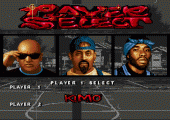
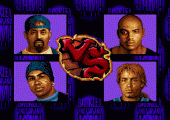
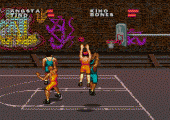
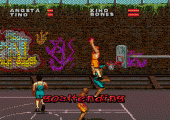
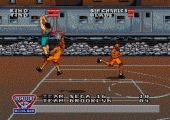
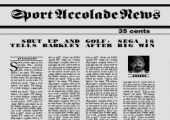
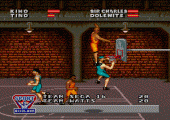
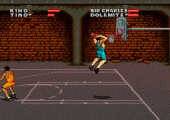
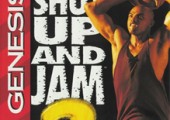
Recent Comments